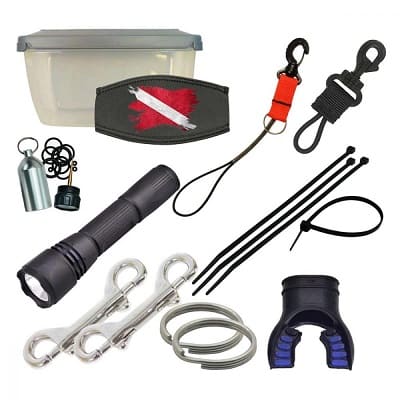Home › A-Z of Diving › Divers Gear › Scuba Accessories › Save a Dive Kit
Building a Well-Stocked Spare Parts Kit
No matter whether you're a scuba newbie or a trainer, all divers should be 'dive ready' by carrying a few spares for fixing 'ill-timed' gear malfunctions.
This save-a-dive kit list is the essential guide for making a scuba diving spare parts box to keep you geared up and diving - even when disaster strikes!
List of Supplies Needed for Saving the Dive
In scuba, if a piece of equipment is going to break, tear, or completely fall apart, it usually happens right before the dive.
Thus, your scuba diving equipment is not immune to the adage known as Murphy's Law.
Here's the thing:
It's very easy to assemble a small box of spare parts and backup gear.
Then, you become more self reliant and you will be able to fix many of the common equipment problems that would normally end the dive.
Pro Tip: Remember, the general wear and tear of dive gear can cause problems before, during, or after the diving has finished. Hence, regular scuba gear maintenance is important to help reduce equipment failure.
Simple Save-a-Dive Kits
A blown O-ring on the tank valve assembly, or a dead battery on the dive computer, can be very costly if it means you can't go diving.
It's a cheap and easy task to replace them, and it only takes a few minutes. But, you won't be able to handle these simple gear and equipment glitches unless you have prepared for it.
Where to start?
You should always take proper care of the scuba gear. But, here's a checklist of essential items that all recreational divers should be putting inside a save-a-dive kit:
- Adjustable wrench
 Baby shampoo (defogger for underwater split-shots)
Baby shampoo (defogger for underwater split-shots)- Carabiners
- Clips and snap hook
- DIN to Yoke adapter
- Disposable contacts (if diving with contact lenses)
- Defog (e.g. anti-fog gel)
- Dive computer batteries
- Dive light batteries
- Dive mask
- Dive watch batteries
- Dry box for storage (e.g. Pelican case)
- Epoxy (water resistant superglue)
- Fin straps and buckles
- Lanyards
- Mask strap
- Mouthpiece
- O-rings (various sizes)
- Paper slips (e.g. for logging scuba dives)
- Pencil
- Port plugs (high and low pressure)
- Reef safe sunscreen
- Regulator mouthpiece
- Sharpie (for marking your dive gear and tanks)
- Silicone Grease
- Snorkel keeper (double loop style)
- Stainless steel O-ring pick
- Tin snips
- Waterproof Band-Aids
- Wetsuit adhesive or repair kit
- Ziploc bag
- Zip ties for fastening
- Zipper wax lubricant (e.g. for dry suits and wetsuits)
Scuba Repair Kit Extras
Specialist or technical divers with more experience, such as those who dive with Type R rebreathers or sidemounts, will need some extra tools to be dive ready, such as:
- Allen key (size 8 as a minimum)
- Bolt snap (including a double ender)
- Bungee (e.g. for backup mouthpiece)
- Christo lube (for lubricating valve and regulator components)
- Dive knives
- Diving-rated glow stick (for illumination)
- Duct tape
- Dry bag
- First Aid Kit, including:
- Barrier protection devices
- Eye and ear drops
- Household vinegar for bites and stings
- Medication to prevent sea sickness
- Surgical tubing)
- Gear bag (waterproof)
- JIS screwdriver
- Magic sponge
- Nail clippers
- Scuba seal lubricant
- Silica gel packs
- Spool
- Tank pressure checker
- Tool kit, including:
- Allen keys
- Duct tape
- Pliers
- Screwdrivers (flathead and Phillips)
- Wrenches
- Viton® O-rings (e.g. for oxygenated gas Mixtures)
Related Information and Help Guides
- How to Become a Scuba Equipment Specialist?
- First Aid and Emergency Equipment Supplies List
- What's the Best Scuba Diving Knife for Beginners?
Pro Tip: It is important to build a save-a-dive kit based on your particular style of diving (e.g. a beginner, seasoned pro) and the local conditions.